
Rhynchobdellida, the jawless leeches or freshwater leeches, are an order of aquatic leeches. Despite the common name "freshwater leeches", species are found in both sea and fresh water. They are defined by the presence of a protrusible proboscis instead of jaws, and having colourless blood. They move by "inchworming" and are found worldwide. The order contains 110 species, divided into 41 genera and three families. Members of the order range widely in length, usually between 7 and 40 mm. They are hermaphrodite. The order is not monophyletic.

Haemadipsidae are a family of jawed leeches. They are a monophyletic group of hirudiniform proboscisless leeches. These leeches have five pairs of eyes, with the last two separated by two eyeless segments. The family is monotypic, containing only the subfamily Haemadipsinae, though as the family can apparently be divided into two or three distinct lineages, at least one of the proposed splits, while not a distinct family, might be a valid subfamily.

Arhynchobdellida, the proboscisless leeches, are a monophyletic order of leeches. They are defined by the lack of the protrusible proboscis that defines their sister taxon, the Rhynchobdellida. Arhynchobdellida is a diverse order, compromising both aquatic and terrestrial, besides sanguivorous and predatory, leeches. The order is divided into two suborders, Erpobdelliformes and Hirudiniformes.
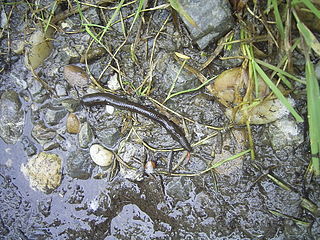
The Hirudiniformes are one of the currently-accepted suborders of the proboscisless leeches (Arhynchobdellida). Their best-known member is the European medical leech, Hirudo medicinalis, and indeed most of the blood-sucking "worms" as which leeches are generally perceived belong to this group. In general, though some leeches suck blood, many are predators which hunt small invertebrates.

Glossiphoniidae are a family of freshwater proboscis-bearing leeches. These leeches are generally flattened, and have a poorly defined anterior sucker. Most suck the blood of freshwater vertebrates like amphibians, crocodilians and aquatic turtles, but some feed on invertebrates like oligochaetes and freshwater snails instead. Although they prefer other hosts, blood-feeding species will opportunistically feed from humans.

Leeches are segmented parasitic or predatory worms that comprise the subclass Hirudinea within the phylum Annelida. They are closely related to the oligochaetes, which include the earthworm, and like them have soft, muscular segmented bodies that can lengthen and contract. Both groups are hermaphrodites and have a clitellum, but leeches typically differ from the oligochaetes in having suckers at both ends and in having ring markings that do not correspond with their internal segmentation. The body is muscular and relatively solid, and the coelom, the spacious body cavity found in other annelids, is reduced to small channels.
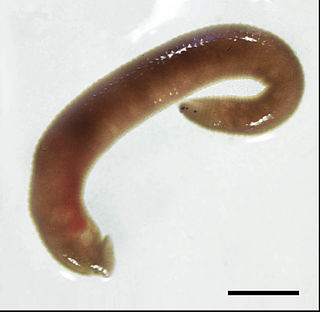
Xerobdellidae are a small family of jawed leeches in the order Arhynchobdellida. Xerobdellidae have three jaws and five pairs of eyes, the fourth and fifth being separated by one or two eyeless segments. The genera placed herein occur in Chile (Mesobdella), Europe (Xerobdella) and Diestecostoma is found in Central and northern South America. This peculiar distribution strongly suggests they are a relict Pangaean group, which had already been present by the start of the Jurassic 250 million years ago.
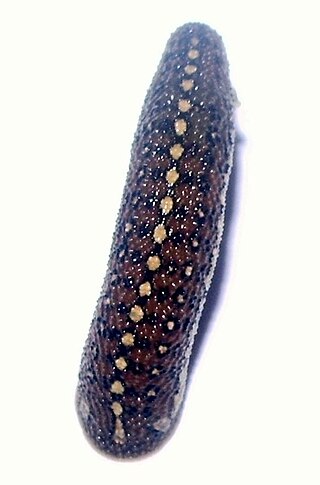
Phytobdella catenifera is a large terrestrial leech found in Peninsular Malaysia. John Percy Moore chose this species’ epithet ‘catenifera’ after the striking chain-striped pattern on the creature's back.

Americobdella is a genus of carnivorous leeches from southern Chile, comprising only the species, Americobdella valdiviana.
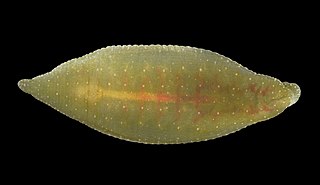
Theromyzon is a genus of leeches belonging to the family Glossiphoniidae. There are about 14 described species in Theromyzon.

Erpobdella is a genus of leeches in the family Erpobdellidae. Members of the genus have three or four pairs of eyes, but never have true jaws, and are typically 20–50 millimetres (0.8–2.0 in) long. All members do not feed on blood, but instead are predators of small aquatic invertebrates, which they often swallow whole.

A teloblast is a large cell in the embryos of clitellate annelids which asymmetrically divide to form many smaller cells known as blast cells. These blast cells further proliferate and differentiate to form the segmental tissues of the annelid. Teloblasts are well studied in leeches, though they are also present in the other major class of clitellates: the oligochaetes.

Branchiobdellida is an order of freshwater leech-like clitellates that are obligate ectosymbionts or ectoparasites, mostly of astacoidean crayfish. They are found in the Northern Hemisphere and have a holarctic distribution in East Asia, the Euro-Mediterranean region and North and Central America, with the greatest species diversity being in North and Central America.

Hirudo is a genus of leeches of the family Hirudinidae. It was described by Carl Linnaeus in his landmark 1758 10th edition of Systema Naturae.

Erpobdellidae is a family of leeches. It is one of the four families belonging to the suborder Erpobdelliformes of the proboscisless leeches order, Arhynchobdellida.
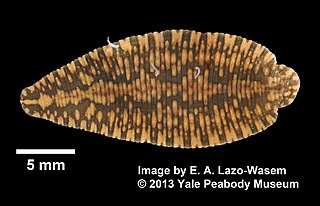
Placobdella parasitica is a species of leech found in North America. Leeches are habitual ectoparasites of vertebrates in aquatic environments. Placobdella parasitica is differentiated from other members of the genus Placobdella by its smooth dorsal surface, simple to complicated pigmentation, and abdomen with 8 to 12 stripes.

The annelids, also known as the segmented worms, are a large phylum, with over 22,000 extant species including ragworms, earthworms, and leeches. The species exist in and have adapted to various ecologies – some in marine environments as distinct as tidal zones and hydrothermal vents, others in fresh water, and yet others in moist terrestrial environments.

The Piscicolidae are a family of jawless leeches in the order Rhynchobdellida that are parasitic on fish. They occur in both freshwater and seawater, have cylindrical bodies, and typically have a large, bell-shaped, anterior sucker with which they cling to their host. Some of the leeches in this family have external gills, outgrowths of the body wall projecting laterally, the only group of leeches to exchange gases in this way.
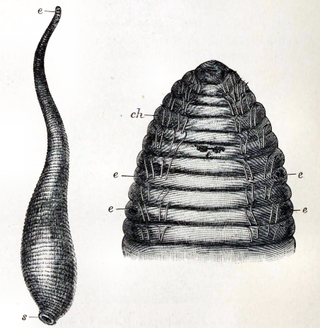
Acanthobdella peledina is a species of leech-like clitellate in the order Acanthobdellida. It feeds on the skin and blood of freshwater fishes in the boreal regions of northern Europe, Asia and North America.
Anna J. Phillips is an American Research Zoologist and curator of Clitellata and Cestoda at the National Museum of Natural History's Department of Invertebrate Zoology. As a parasitologist her research focuses on leeches and tapeworms, by studying their diversity, relationships, and host associations. She has traveled all over the world with her fieldwork to study the diversity of these invertebrates on a long range.


















